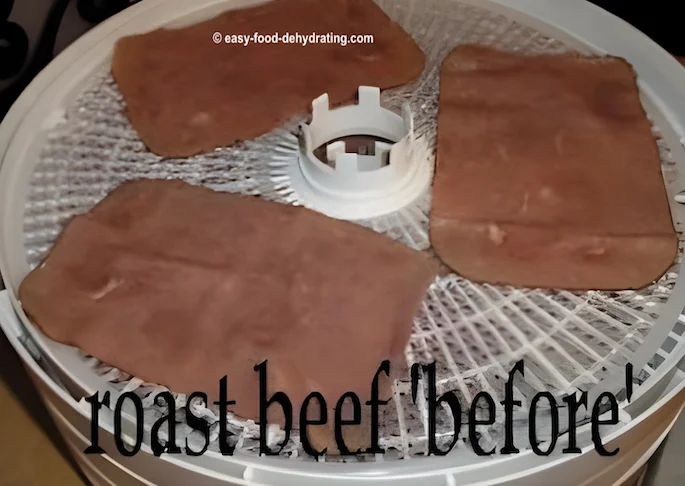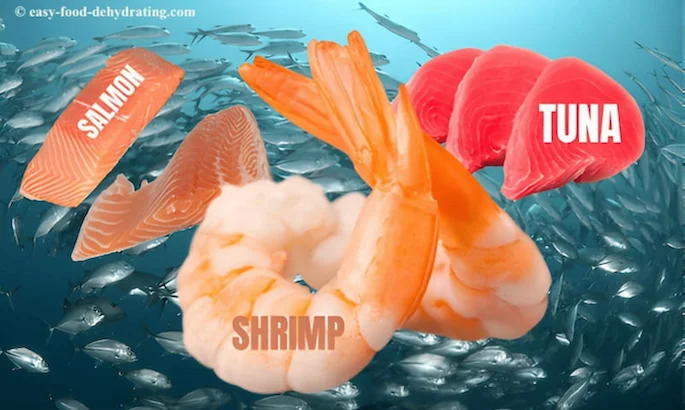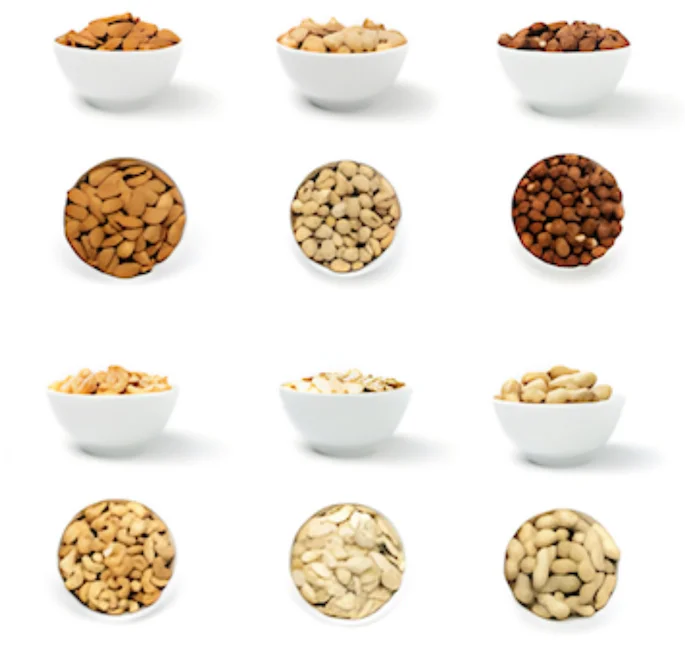How to Dehydrate Meat: The Ultimate Guide to Safe, Tasty, Long-Lasting Meat Preservation

Susan Gast | Author and blogger at Bored Boomers, Beesville Books, A New Sober You and Easy Food Dehydrating
Dehydrating meat is a great way to preserve meat safely without using canning or freezing methods. A food dehydrator removes moisture, extending the shelf life while enhancing flavor.
In this guide, you'll learn step-by-step how to dehydrate meat, including the best meats to use, proper drying temperatures, storage tips, and even recipes for homemade beef jerky!

Click an IMAGE Below for FULL Information on:
Beef, Chicken, Pork, Turkey, or Seafood (Tuna, Salmon, Shrimp)
How to Dehydrate Meat (Leftovers)!
Dehydrating leftover meat is a simple process! This guide will walk you through safe dehydration, storage, and creative ways to use dried meat in recipes.
We've also included an easy beef jerky recipe further down the page!
Frequently Asked Questions
How do you dehydrate meat?
How do you dehydrate meat?
Read below for full step-by-step instructions on dehydrating beef, chicken, turkey, pork, and seafood.
Can you dehydrate ground meat?
Can you dehydrate ground meat?
Yes! Ground meat dehydration instructions are included further down this page.
What’s the best method to dry meat?
What’s the best method to dry meat?
A food dehydrator is the most efficient method, but meat can also be dried in an oven or sun-dried under the right conditions.
What temperature should I use to dehydrate meat?
What temperature should I use to dehydrate meat?
Cooked meat should be dehydrated at 160°F (70°C) to ensure safety. Always refer to your dehydrator's owner's manual for specific guidelines.
Understanding Meat Dehydration
The Four Main Ways to Preserve Meat
✔ Dehydrating
✔ Smoking
✔ Freeze-drying
✔ Curing with salt
To make the most of family meal prep, consider cooking extra meat and dehydrating it for future use!
Why Dehydrating is the Best Option for Long-Term Storage
Dehydrating meat is one of the best long-term storage methods because it extends shelf life without needing refrigeration or freezing. By removing up to 95% of moisture, it becomes lightweight, compact, and shelf-stable for months or even years. Unlike freezing, there’s no risk of freezer burn or spoilage during power outages, making it a reliable option for stocking up and outdoor adventures.
This method also preserves nutrients and enhances flavor without relying on preservatives like curing. It’s safer and simpler than canning, and rehydrating is as easy as soaking in water or broth.
Preparing Meat for Dehydration
Because we are dehydrating cooked meats, no further cooking is needed before drying. Follow these simple preparation steps:
Choosing the Best Meats for Dehydration
- Select lean cuts to prevent spoilage (fat causes rancidity).
- Trim off visible fat before dehydrating.
How to Slice Meat for Even Drying
- BEEF: Slice evenly to ensure consistent dehydration. Read ALL about Dehydrating Beef here.
- CHICKEN: Cut into uniform strips. Read ALL about Dehydrating Chicken here.
- TURKEY: Same method applies. Learn about Dehydrating Turkey here.
- PORK: Trimmed, lean slices work best. All about Dehydrating Pork here.
- SEAFOOD: Dehydrate fish carefully. Visit our guide on Dehydrating Seafood here.
How to Dehydrate Fresh Ground Beef
The Importance of Cooking Ground Beef Before Dehydration
Ground beef must be cooked before dehydration:
- Brown the meat in a pan, breaking it into small, uniform crumbles.
- Drain excess fat and pat dry with a paper towel.
- Spread evenly on dehydrator trays.
Ideal Temperature for Dehydrating Cooked Meat
Set your dehydrator to 160°F (70°C) and dry meat until it is leathery but still pliable.
- If meat isn’t dried long enough, bacteria can grow.
- Over-drying can make meat too tough to chew.
💡 Tip: Use our Fahrenheit to Celsius converter here on our site!
Why Cooked Meats are Best
For faster, safer dehydration, use pre-cooked sliced meats like roast beef, chicken, or turkey. Simply slice and dehydrate for quick results!
Best Meats for Dehydration

Some meats dehydrate better than others. The best options include:
✔ Lean beef cuts (sirloin, flank, London broil)
✔ Skinless chicken
✔ Lean turkey
✔ Salmon
✔ Venison (Be aware of recent health advisories)
Stocking Up on Flavor!
Use stock to enhance flavor! When rehydrating meat, use broths or stocks instead of plain water. Try Better Than Bouillon for added taste.
How to Make Delicious Homemade Beef Jerky

Dehydrator Method for Beef Jerky
Ingredients:
- 1 lb beef (sirloin, flank, or London broil)
- 2 tablespoons soy sauce
- 2 teaspoons Worcestershire sauce
- 1 teaspoon onion powder
- 1 teaspoon garlic powder
- 1/2 teaspoon black pepper
- 1/4 teaspoon cayenne pepper (optional)
- 1/4 cup brown sugar (optional)
Instructions:
- Slice beef into ¼-inch thick strips (trim fat).
- Marinate in a resealable bag for at least 4 hours.
- Set dehydrator to 165°F and dry for 6-8 hours.
- Store in airtight containers.
💡 Tip: Use our Fahrenheit to Celsius converter here on our site!
Oven Method for Beef Jerky
Instructions:
- Preheat oven to 200°F.
- Place beef on a wire rack over a baking sheet.
- Bake for 4-6 hours until slightly chewy.
- Store in an airtight container in the refrigerator.
💡 Pro Tip: Use a food vacuum sealer for long-term storage!
💡 Tip: Use our Fahrenheit to Celsius converter here on our site!
Best Marinades & Flavor Enhancements
Classic Smoky Teriyaki Marinade
A perfect balance of sweet and savory with a hint of smokiness.
- ¼ cup soy sauce
- 2 tbsp Worcestershire sauce
- 1 tbsp honey or brown sugar
- 1 tsp liquid smoke
- ½ tsp garlic powder
- ½ tsp onion powder
- ¼ tsp black pepper
Spicy Chipotle Lime Marinade
For a bold, zesty kick with a smoky heat.
- ¼ cup lime juice
- 2 tbsp olive oil
- 1 tbsp adobo sauce (from canned chipotle peppers)
- 1 tsp smoked paprika
- ½ tsp cumin
- ½ tsp garlic powder
- ¼ tsp cayenne pepper
Sweet & Savory Maple Bourbon Marinade
A rich, slightly sweet marinade with a deep, savory flavor.
- ¼ cup maple syrup
- 2 tbsp bourbon (or apple cider vinegar as a substitute)
- 1 tbsp soy sauce
- 1 tsp Dijon mustard
- ½ tsp black pepper
- ½ tsp smoked paprika
Check out this guide to the eight best cuts of beef, brought to you by The Best Stop.
Pro Tips for Perfectly Dehydrated Meat
💡 Paul Bee’s Tip: Get lean roast beef sliced 1/16" thick from the deli!
💡 Sarah’s Tip (Australia): Use low-fat canned chicken—it rehydrates perfectly!
Try Our Beef Stew!
Use your dehydrated meat to make a delicious beef stew!
Expand Your Food Preservation Skills
Thanks for learning how to dehydrate meat safely!
Don't forget to grab your free Six Simple Steps eBook! It’s packed with tips for dehydrating everything from fruits and veggies to dog treats. Get it here.
Before You Go...
If you like the content, please give me some love by clicking on the 🩷 in the lower right hand corner (on just about all my pages). This signals to me that you find it enjoyable and useful. Thank you so much!






















